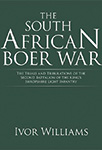|
THE SOUTH AFRICAN BOER WAR
The Trials and Tribulations of the Second Battalion of the
King’s Shropshire Light Infantry
by Ivor Williams
|
 Ivor Williams, former Welsh Guardsman and now In-Pensioner at the Royal Hospital, has had a most interesting and varied life. Born in Hereford in 1932, Ivor is the son of a soldier of the King’s Shropshire Light Infantry who was recalled to the colours in 1939, and was one of the last to be evacuated from France in June the following year. In 1949, Ivor joined the Welsh Guards, serving in London, Germany, and Egypt. He left the Army in 1957, and emigrated to Australia where he served as a Federal Police Officer for 32 years. His time in Australia led him to write his first book Captain Ronald Campbell of Bombala Station, Cambalong (reviewed in the Winter 2017/18 edition of this magazine), telling the story of a Scotsman who emigrated to New South Wales in 1832. Ivor Williams, former Welsh Guardsman and now In-Pensioner at the Royal Hospital, has had a most interesting and varied life. Born in Hereford in 1932, Ivor is the son of a soldier of the King’s Shropshire Light Infantry who was recalled to the colours in 1939, and was one of the last to be evacuated from France in June the following year. In 1949, Ivor joined the Welsh Guards, serving in London, Germany, and Egypt. He left the Army in 1957, and emigrated to Australia where he served as a Federal Police Officer for 32 years. His time in Australia led him to write his first book Captain Ronald Campbell of Bombala Station, Cambalong (reviewed in the Winter 2017/18 edition of this magazine), telling the story of a Scotsman who emigrated to New South Wales in 1832.
Ivor Williams’ latest book is about the Second Battalion, King’s Shropshire Light Infantry in the South African War, a regiment that he knows well, although the scope of this book goes well beyond one unit. Both his grandfathers served in the Boer War; and his interest in that war was rekindled by seeing a memorial in New South Wales to Australian soldiers of the Bega Mounted Rifles, all volunteers who died in South Africa.
In this fascinating book, based on thorough research and supported by excellent archive images, the author explores the multitude of army units, including yeomanry and militia, that were to bear men of Shropshire and Herefordshire to war in 1899. As he says in the opening pages of the book ‘Why was it necessary for these heroes of Herefordshire to be distributed through thirty different army regiments to serve queen and country?’ The Cardwell reforms of the 1870s certainly contributed to this diversity of units, while also providing the dynamo of local and community support for recruiting, both in 1899 and again in 1914.
As the author observes, the Boer War has been overshadowed by the two world wars of the 20th century, and with one recent centenary and another in the not-too-distant future, it seems entirely appropriate that we should be reminded of a war that is in danger of disappearing from view. The over-confidence of both politicians and military commanders in 1899, and the ill-equipped state of the British Army at the time, is often conflated with the situation in 1914, and yet in many respects the failings during the Boer War, and the reforms that followed, were to be a saviour for the next. The popular cry that the war would be ‘all over by Christmas’ derives not from The First World War, but from Redvers Buller’s over-confident prediction in October 1899 that the British flag would be flying in Pretoria by Christmas Day. Thankfully, Lord Kitchener, latterly Commander-in-Chief during the Boer War, was not confident of a short war in 1914.
The considerable detail in Ivor Williams’ book reminds the reader that the Boer War was much more than a skirmish – it was a war in which men of Herefordshire and Shropshire, and other counties, and indeed the countries of the Empire, fought and died. The war was not a short one, and given the many parallels with the unconventional wars of the next two centuries, and particularly this century, it deserves to be studied more than it is. This most readable book adds to that knowledge.
The Editor
AuthorHouseUK
|
|